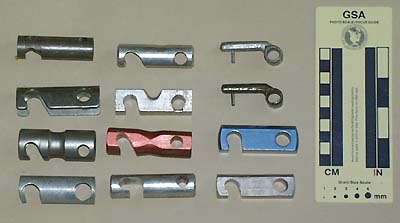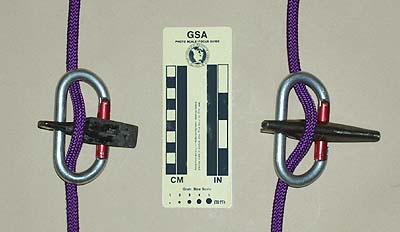
Carabiner Brake Bar Methods
People realized long ago that adding a brake bar to a carabiner provided superior rappel to the classic Dülfersitz (body rappel), and that by linking several such carabiners together with chain links, descending rings or carabiners one could vary the friction in increments. There is no point is showing all of the combinations of different brand and style carabiners and brake bars here, but the basic ideas are shown in this gallery:

I also wrote this light-hearted history of the rise and fall of double brake bar rappelling:
Don't overlook some closely-related ideas that I placed in the Single Brake Bar Descenders Category.
Brake Bars

I don't go out of my way to collect carabiners or brake bars, but naturally, I've ended up with a number of variations over the years. The Gallery shows some loose brake bars from my collection. Many of my brake bars are on rappel racks, so look through the Open-frame and Closed-frame rappel rack pages for many more brake bars.

Thease are the pages in the Gallery:
I prefer aluminum brake bars for several reasons.
My primary reason for preferring aluminum is that aluminum brake bars run cooler than similar-shaped bars made from the common alternative metals. Aluminum's thermal conductivity is three to five times that of steel, ten times that of stainless steel, and twenty times that of titanium.
Rappel rack geometry naturally leads to the rope running against the frame unless one provides some special brake bar feature to prevent this. With solid aluminum bars, filing a shallow guide groove is sufficient. Tubular steel or stainless steel brake bars generally do not have enough wall thickness to allow filing rope-centering grooves.
The main objection that I hear against aluminum bars is that they leave black marks on ropes. These marks do not harm the rope. I've never seen a study showing that the residue weakens ropes. Chemically it would make no sense - aluminum oxide is relatively inert - and anyone who has looked under a microscope or electron microscope will soon recognize that the oxide particles wil not cause mechanical damage either. This reduces the objection to mere aesthetics. If you want a pristine rope, don't use it; if you prefer caving of climbing, get used to soiling your rope.
Darrel Tomer's Experimental Brake Bars
I'd just like to share some interesting ideas that Darrel Tomer developed. Some of these are rather unique, to say the least. I'll provide Darrel's comments on each of these in the Gallery.

| ID |
Descender |
Detailed Description |
Weight (including carabiner) |
| 475 |
Tomer #1 |
Small finned brake bar, steel retainer, noncommercial. |
169 |
| 476 |
Tomer #2 |
Large finned brake bar, retaining bolt, noncommercial. |
166 |
| 477 |
Tomer #3 |
Small finned brake bar, steel retainer, carabiner
gate locked by sleeves, noncommercial. |
286 |
| 478 |
Tomer #4 |
Small finned brake bar for pear carabiner, steel
retainer, carabiner gate locked by sleeves, noncommercial. |
272 |
| 479 |
Tomer #5 |
Gate spanning brake bar, asymmetrical friction
adjustment, broken gate carabiner, noncommercial. |
209 |
| There is no Tomer #6 (there
never was) |
| 480 |
Tomer #7 |
Gate spanning V-notch carabiner, steel retainer,
noncommercial. |
168 |
| 481 |
Tomer #8 |
Adjustable gate spanning aluminum brake bar with
threaded steel V-bolt, noncommercial. |
396 |
| 482 |
Tomer #9 |
Adjustable gate spanning steel brake bar with
threaded V-notch adjustment, noncommercial. |
290 |
 An
Idea to Forget (Until it's the Only Option Left)
An
Idea to Forget (Until it's the Only Option Left)
Open any old climbing book and they'll probably show using pitons as brake bars. For completeness, I'll show a Lost Arrow and a standard angle used as brake bars. I can do a lot better than using a piton, especially if I have some more carabiners available, so I won't go into this idea any further (let alone touch the idea of using a hammer handle or an ice screw as a brake bar).

For far more content, use a larger monitor and a full-width window.
Hundreds of cell phone users complained and asked me to for a simpler, mobile friendly site. In particular, they wanted me to limit each page to a small number of pictures and minimize my use of text. This new site provides what they asked for.

